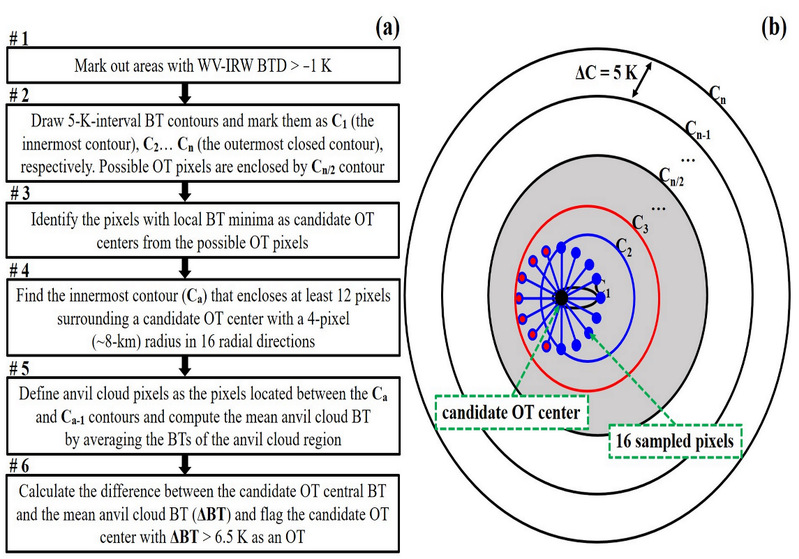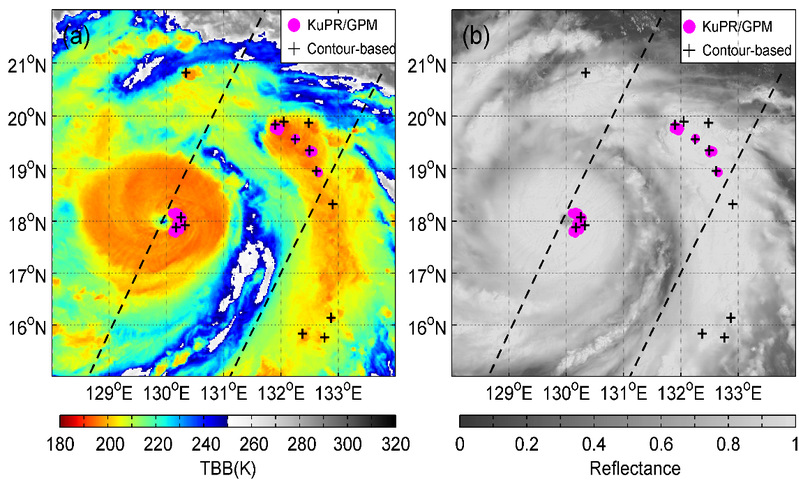Professor Yuan Wang's group with the School of Atmospheric Science at Nanjing University has made new progress in convection detection and tracking. The related paper, titled A Contour-based Algorithm for Automated Detection of Overshooting Tops Using Satellite Infrared Imagery, was published in IEEE Transactions on Geoscience and Remote Sensing (TGRS), a top remote sensing journal with an impact factor of 4.662 for 2017.
Overshooting convection is a type of deep and dangerous convection that features limited horizontal extent (less than 4 km in diameter) and short duration (15 mins or less). It exhibits an intense updraft that develops solidly in the vertical extent and that can rise beyond the troposphere and penetrate the lower stratosphere. Many studies have demonstrated direct relationships between overshooting convection and 1) disastrous weather such as lightning activity, hail, tornadoes and heavy rainfall and 2) tropical cyclone activities such as cyclogenesis and intensity change; and 3) the cross-tropopause transportation of materials that affect global climate such as ice particles, water vapor, and so on. Therefore, the detection of overshooting convection is of great significance in meteorology, climatology and atmospheric environment study.
The overshooting top (OT), defined as the cloud top of overshooting convection, appears as a cauliflowerlike protrusion in the visible (VIS) imagery and a small localized cold region in the satellite infrared (IR) imagery. Based on finer spatiotemporal resolution imagery generated by the new generation geostationary satellites, Professor Wang Yuan's group develops a contour-based algorithm for automated detection of overshooting tops (Fig.1). The accuracies of the OT detection algorithms are evaluated with 159 Global Precipitation Measurement (GPM)-observed OT events collected from July 2015 to July 2017. The results indicate that the contour-based algorithm performs better than the original IRW-texture algorithm. The contour-based algorithm achieves a probability of detection (POD) of 67% and a false-alarm ratio (FAR) of 46%. Compared to the original IRW-texture algorithm, the contour-based algorithm increases the POD by 9% and decreases the FAR by 42%. Fig.2 serves as an example for OT detection.
This work was supported in part by the National Natural Science Foundation of China under Grant 41505086, Grant 41575130, and Grant 41675054 and in part by the National Fundamental Research (973) Program of China under Grant 2015CB452800. Doctoral candidate Liangxiao Sun was the first author and Doctor Xiaoyong Zhuge and Professor Yuan Wang were the corresponding authors.

Fig. 1. (a) High-level flowchart of the contour-based OT detection algorithm, and (b) schematic of Procedure #4, in which the 16 pixels (blue and red dots) surrounding the candidate OT center (black dot) are separated into two groups according to whether they are enclosed by C2.

Fig.2 (a)IR imagery and (b) VIS imagery of Himawari-8. The magenta dots represent the KuPR/GPM-observed OTs, the black plus signs represent the OTs detected by the contour-based and the dashed line indicates the edge of the KuPR swath.
Link to the paper and its references:
Sun, L. X., X. Y. Zhuge, and Y. Wang, 2018: A Contour-based Algorithm for Automated Detection of Overshooting Tops Using Satellite Infrared Imagery. IEEE Trans. Geosci. Remote Sens., doi: 10.1109/TGRS.2018.2857486.
Zhuge, X.-Y., J. Ming, and Y. Wang, 2015a: Reassessing the use of inner-core hot towers to predict tropical cyclone rapid intensification. Wea. Forecasting, 30, 1265–1279, doi: 10.1175/WAF-D-15-0024.1.
Zhuge, X.-Y., J. Guan, F. Yu, and Y. Wang, 2015b: A new satellite-based indicator for estimation of the Western North Pacific tropical cyclone current intensity. IEEE Trans. Geosci. Remote Sens., 53, 5661–5676.
Sun, L. X., X. Y. Zhuge, and Y. Wang, 2017: Favorable environments for the occurrence of overshooting tops in tropical cyclones. Adv. Atmos. Sci., 34(4), 532–544, doi: 10.1007/s00376-016-6122-y.
